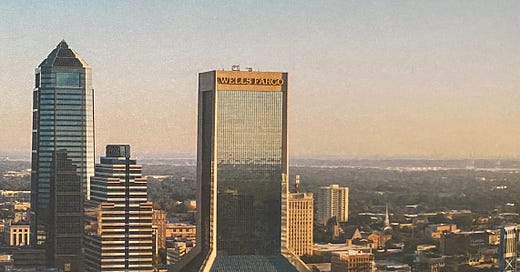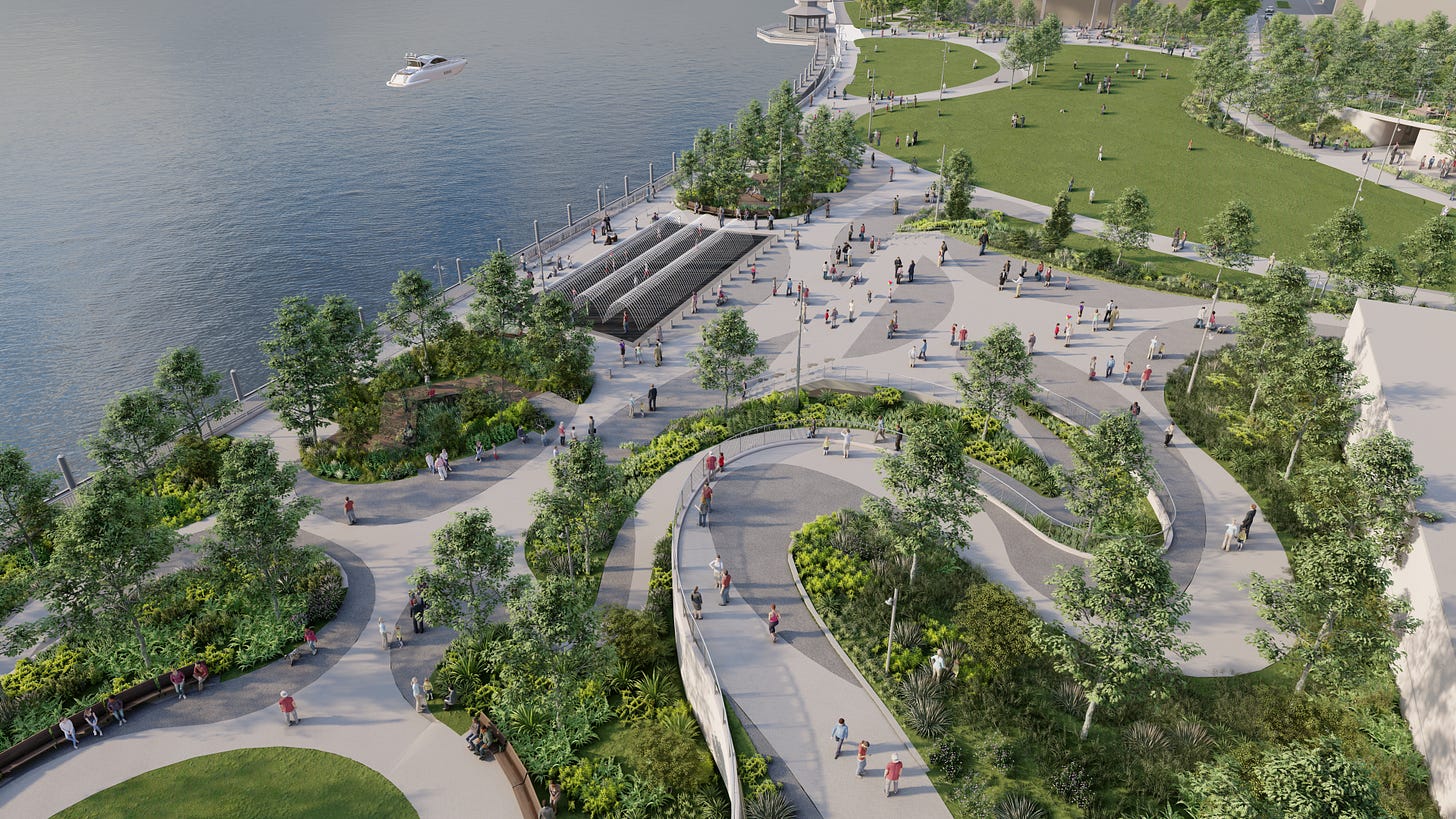During the 27 years I worked in historic downtown on the Northbank, I sometimes walked to The Landing to sit or stand along the St. Johns River. Not necessarily to buy something or have a lunch meeting, not to, as it were, “monetize” my being there. Although sometimes I did that. I went just to quietly watch the River St. Johns, reconnecting I suppose to something larger and more meaningful than whatever plagued my little pea-brain at the time.
A respite. From the constant busy-ness that occupies a life.
In his The Negro Speaks of Rivers, Langston Hughes recounts how the poet knows rivers, “rivers ancient as the world and older than the flow of human blood in human veins.” The poet’s soul, he says, “has grown deep like the rivers.”
Maybe we all feel something timeless and akin to what Hughes knew when we sit quietly along our greatest downtown natural asset. Maybe our souls grow deep too.
“Riverfront Plaza”
Currently, the place where the cows once forded the River has begun Phase I of its maybe final transformation from The Landing through its life as “Lenny’s Lawn” into what will be “Riverfront Plaza.”
Some locals cleverly call its interim life “The Lawnding,” whose open space—especially the vista from the Independent Life-Modis-Wells Fargo lobby—I at least found refreshing. It needed shade and amenities for sure, but the direct open connection to the River suggested that we might just create our mini-version of a central green space, a central public park, especially for the folks who work and live downtown. And for those future folks we hope will live and work downtown.
A respite.
True confession: I don’t like the new name. It tells nothing, no story of the people who came before us “settling” this place we call home. It situates us absolutely no where. And it sounds like every other place we’re constructing along the St. Johns—River’s Edge, One Riverside, Riverfront Plaza. As if we need a constant reminder that there’s a river out there somewhere. In a way, that does make some sense, given that we keep walling off the St. Johns with high rise buildings situated extremely close to the water’s edge, “monetizing the view” for a relatively small group of people, creating narrow little “sight lines” for the rest of us. I imagine folks someday walking along Riverside Avenue suddenly standing in three feet of water, wondering where it came from.
Jacksonville renames places all the time, so we could I suppose change “Riverfront Plaza” into something else someday, allusions to the Timicua or some such.
The Drawings Tell a Tale: Phase I and Phase II
Construction began July 10th on Phase I of this latest riverfront re-development, which, according to the City of Jacksonville announcement, should take two years to complete and will include removing a portion of Independent Drive, converting part of Hogan Street into a pedestrian plaza, rebuilding the bulkhead and riverwalk, and establishing a “multipurpose lawn, a series of curving walkways, native plant gardens, a water play area and the café with roof-mounted playground.”
I love the idea of native plant gardens and playable water features.
It’s Now or Never: Phase II
Phase II, the City announcement continues, “will include such features as a rain garden, water feature, civic stairs, a beer garden and a pedestrian ramp from the Main Street Bridge.”
Sounds lovely, right?
Here’s the problem: there’s no mention of the 44 story residential high-rise to be located on the park’s northeast corner, despite Downtown Investment Authority (DIA) having chosen a developer—American Lions—to purchase and develop approximately one acre of publicly-owned land. DIA renderings show the residential development, named of course “River View Plaza,” with “civic stairs” at its base. The high rise, which will include no fewer than 300 residential units, has yet to be presented to City Council suggesting the final public tax-dollar subsidy hasn’t been determined or approved.
Seven Acres and Shrinking?
According to DIA, the reconfigured site—which incorporates The Landing’s paved drop off area and the roadway between the Performing Arts building and The Landing property—totals 7 acres. But not 7 acres of public park area, since a good acre will be consumed by the residential high-rise. So, let’s say 6 acres total.
Memorial Park, by comparison, is a 6 acre green space located in Riverside adjacent to the St. Johns and populated by Live Oaks, a simple walkway, wonderful flowering plants and trees, and a statue. It’s incredibly popular, a space where people make up their own play—walking a dog, throwing a frisbee, being married. The St. Johns, the oak trees and their shade, a simple walkway and open green space seem enough to attract folks. It’s loved and maintained by a group of neighborhood volunteers, and nearby restaurants and shops benefit from the the park’s popularity. Of course, lots of dense apartment buildings, high- and low-rise, together with single family houses populate the surrounding neighborhood.
One wonders: what is the actual size of the Plaza’s multipurpose lawn? How many people will this green turf area—is it living grass—or the entire area accommodate? how much shade will the trees produce? how permeable are the walkways and paved areas? and what guarantees maintenance and continued public ownership and access?
Will this “activation” save historic downtown?
No doubt “The $64,000 question,” the answer to which might take years. Let’s say we hope so. We all know that downtown affordable residential housing—for all family and income types—is the key to ensuring a vibrant downtown, but that’s a conversation for another day.
For decades, the City of Jacksonville has held tight to the idea that too much downtown riverfront property doesn’t produce tax revenue, and that “monetizing”this space—selling, giving away, leasing it to developers—will not only produce tax revenue but attract folks to historic downtown thus helping save it. We just have to get the right set of activities.
Our Civic Heart and Soul
I do wonder, however, if we are missing something basic: the role an open natural green space, especially one that borders a river, might play in reconnecting us to something ancient, a place where we might deepen our civic soul.
With privatization of the former Kids Campus, the shipyards, and the courthouse and city hall spaces, all that remains for a spacious historic downtown park is The Lawnding, and of course the linear park from Met Park along the St. Johns to San Marco. The linear park idea—critically important to ensuring broad public access to the St. Johns—does not lend itself to an ample public gathering place in the heart of historic downtown.
Whatever locals call it, we need to ensure this downtown centrally located park is as spacious as it can be, and that its primary purpose remains a public one.
What You Can Do
Mayor Donna Deegan is meeting with Jacksonville residents in a set of 14 “community conversations”—one per each city council district with city council members present—that began yesterday (August 3) in Mandarin. Talk with her and her people about historic downtown, the public and resilient nature of Riverfront Plaza, the amount of consideration being given to its percentage “greenness,” and whether or not the 44 story residential high rise might find another location.
This is a receptive young administration that wants to partner with us.
Click this link to find the complete list with meeting dates and locations: https://www.coj.net/mayor/community-conversations
https://www.coj.net/welcome/news/construction-begins-at-riverfront-plaza
https://dia.coj.net/Meetings/DIA-Resolutions/2022/R-2022-09-02-American-Lions-Riverfront-Plaza-EXECU
https://www.jaxdailyrecord.com/news/2022/sep/09/six-projects-reshaping-downtown-jacksonville/









Thank you for your very thoughtful comments about our Northbank riverfront. Cities around the country have enjoyed great economic, social and civic benefits by creating large beautiful and active parks along their downtown waterways. The positive return from investing in public space has been enormous, from creating community pride and enjoyment to the successful economic development adjacent to these parks. Jacksonville has a once in a lifetime chance to open the large number of public spaces to our citizens, by creating a destination worthy exciting, appealing, well-tended and connected park system along the Northbank, from the Riverside Arts Market to Metropolitain Park. Private use does not seem to be the highest and best use of this precious land. This is our time, Jacksonville. Susan Caven
Look on YouTube "A Vision for Jacksonville". This is a years long initiative at visioning that I led under the AIA Jacksonville chapter. This is what a vision looks like.